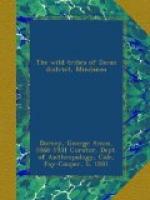[1] See page 154.
Other spirits, less friendly, have existed from the first time. Of these one named Siling causes much trouble by confusing travelers through the forest. Spirits of unborn children—mantianak[2]—wander through the forest crying “ina-a-a” (mother), and often attack human beings. The only way persons thus assailed can hope to escape is by running to a stream and throwing water on the abdomens of their pursuers.
[2] Frequently called busau.
The powerful spirit Tama owns the deer and wild pig, and is usually kind to hunters who offer him proper gifts. Should they fail in this duty he may cause them to become lost or injured. Mandalangan (Mandangan) is known as a powerful spirit who loves war and bloodshed, but he is so closely interwoven in the minds of the people with TimanEm that it is doubtful if he should be classed as a separate spirit.
In addition to these beings are the kawE, or shades of the dead, the chiefs of whom are the people who created the earth. During life the kawE live in the body, but after death they go to the sky where they remain the greater part of the time. They do return to earth at certain seasons, to aid or injure the living, and it is usually one of their number who keeps guard over the rice-fields. Certain persons known as balian can talk to these spirits and from them have learned the ceremonies which the people should perform at certain seasons, and at the critical periods of life. In the main these ceremonies are so similar to those just described that it is useless to repeat. The proceedings at a birth, marriage, or death are practically identical with the Kulaman, as are also those at planting and harvest time. A slight variation was noticed after the rice planting at Padada, when all the workers placed their planting sticks on an offering of rice and then poured water over them “so as to cause an abundance of rain.” Another difference is noticed following the death of a warrior. His knife lies in its sheath beside the body for seven days and during that time can only be drawn if it is to be used in sacrificing a slave. If such an offering is made it is carried out in much the same way as the Bagobo sacrifice, except that the bereaved father, son, or brother cuts the body in halves.
If it is impossible to offer a slave, a palm leaf cup is filled with water and is carried to the forest. Here the relatives dance and then dip the knife and some sticks in the water for “this is the same as dipping them in blood.” Later they are carried back and hung up in the house of mourning.
According to the long established custom, warriors must go to fight once each year, when the moon is bright. Spears, fighting knives, bows and arrows, sharpened bamboo sticks, and shields have long been used, and to these several guns have been added in recent years.
The attack is from ambush and the victims are generally cut to pieces, although women and children are sometimes taken captive. Tufts of hair taken from the slain are attached to the shields of the warriors, and an arm is carried back to the home town “so that the women and children can cut it to pieces and become brave.”




